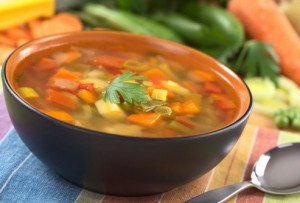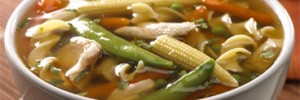Preparing foods for soup
If you are going to puree vegetables to thicken soup or to make a creamy soup, it doesn’t matter much how you cut them. It does, however, help to cut them to about the same size so they all finish cooking at the same time. If, however, you’re going to leave whole cubes of vegetables or meat in the soup, keep two things in mind: Uniform cutting will allow the foods to cook evenly, so that your potatoes and carrots are both tender, instead of one being mushy while the other is still hard. And uniform cutting into small pieces will allow you to eat the soup elegantly, without either cutting in the bowl or cramming too-large pieces of food into your mouth.
 Using leftovers in making soup
Using leftovers in making soup
One of my first cooking teachers made cream-of-something-or-other almost every night with leftover vegetables. She combined the vegetables with stock and seasonings, pureed, and reheated, sometimes with cream, sometimes with milk or yogurt, sometimes with nothing. This is a great idea, but remember one thing: Rinse off unwanted seasonings with boiling water before beginning. That leftover broccoli may be great, but do you really want chili-vinaigrette in your soup? You get the idea.
Almost any leftover whose flavor does not conflict with the basic seasonings of your soup is fair game: pasta, rice, even bread; meat, fish, or poultry; vegetables, even those such as mashed potatoes, which can blend in nicely.
Thickening soup
Although thickening is no longer considered essential, it adds a sense of luxury in many instances. There are four types of thickeners:
- Eggs: These lend superb creaminess and a nice richness to soup. There are two ways to use them: If you just stir some beaten eggs into soup, you’ll get what amounts to egg drop soup. The eggs coagulate, are readily identifiable, and add a certain meatiness to many soups; it’s a nice method. The classic way to use eggs as a thickener is to beat a couple of yolks, then stir some of the hot soup into the yolks, then gradually add the yolks back into the soup. Treated this way, the eggs do a beautiful job of building up the body of the soup. But it’s largely cosmetic. Given that you probably don’t get to eat as many eggs as you would really like to anyway, I’d save them for breakfast.
- Cream: Thick cream, sour cream, creme fraiche, or yogurt all can be added to adjust the body of any soup, as long as you don’t mind the added calories and like the flavor. Add a little at a time and proceed with care, tasting frequently, especially with yogurt, which can quickly overwhelm subtle flavors.
- Flour and cornstarch: You can thicken a soup by adding flour in the early stages (just sprinkle a tablespoon or more on the vegetables during the initial cooking) or by adding cornstarch (mix one tablespoon of cornstarch with two tablespoons of water or stock) at the end. Either will thicken a soup. But I don’t see the reason for it, since neither adds flavor. I imagine it came about during those times when more expensive thickeners, such as eggs, vegetables, or grains, were in short supply.
- Rice, potatoes, and bread: You need a thickener in pureed soups, if for no other reason than because thin purees are depressing and meager-looking. But all you need to do to ensure that your puree will be pleasantly thick is to add a potato to the mix, or about one-half cup of rice, or a slice or two of bread (the bread can be added just a few minutes before pureeing). Any of these will give soup the creamy richness you’re looking for.
